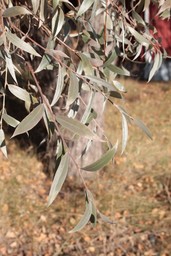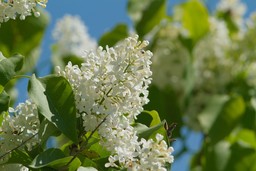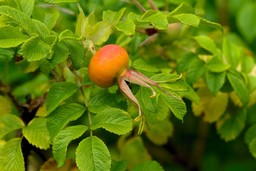4. Plants
Plant reproduction
Most plants reproduce with their flowers. The flower contains two kinds of reproductive structures: stamens and pistils. Stamens produce pollen grains. These pollen grains are transported from one flower to another either by the wind or by a pollinator, such as an insect. The pistils receive these pollen grains, and interact with them. This process is known as pollination.
After pollination, a process known as fertilization begins. In fertilization, the pollen grain and the egg cell of the pistil are fused together. When this happens, a seed begins to develop. In time, the seed is released and can grow into a new plant.
After pollination, a process known as fertilization begins. In fertilization, the pollen grain and the egg cell of the pistil are fused together. When this happens, a seed begins to develop. In time, the seed is released and can grow into a new plant.
Park trees
 Trees are large plants. The main parts of plants can be easily identified when looking at them: their roots, their stems or trunks, and their leaves are all clearly visible. Trees use their sturdy roots to attach themselves into the ground. Their stems grow upwards towards light, and their leaves produce energy from this light through a process known as photosynthesis. Because cities have usually been built on locations with good climate conditions, many kinds of tree species thrive in them. Various kinds of broad-leaf tree species can be found in parks, for example.
Trees are large plants. The main parts of plants can be easily identified when looking at them: their roots, their stems or trunks, and their leaves are all clearly visible. Trees use their sturdy roots to attach themselves into the ground. Their stems grow upwards towards light, and their leaves produce energy from this light through a process known as photosynthesis. Because cities have usually been built on locations with good climate conditions, many kinds of tree species thrive in them. Various kinds of broad-leaf tree species can be found in parks, for example. The oak (species 1 in the image below) is one of the most magnificent trees in European parks. It is known for its acorns, which are used as food by squirrels and birds. Wood from oak trees can be used to produce furniture and flooring.
The leaves of a maple tree (2) is easily recognizable. During the autumn, the leaves of the maple tree change into a deep red color, as the maple collects all of the valuable chloroplasts into its trunk when preparing to drop its leaves for the winter.
The lime tree (3) is a common park tree. It can be recognized from its heart-shaped leaves.
The ash tree (4) is a relatively rare park tree. Its leaves consist of leaflet pairs. The elm tree (5) can be recognized by looking at its sharp, dark leaves.
Some trees, such as birches and alders, are wind-pollinated. This means that their pollen grains are transported from one tree to another by the wind. To make sure this happens, wind-pollinated trees produce large quantities of pollen during the spring. This can cause problems for people with pollen allergies. As a result, birch and alder trees are not usually grown in cities or in parks.
Coniferous trees are also often found growing in parks. They do not reproduce via flowers. The most common coniferous trees are the pine and the spruce. Most coniferous trees are evergreen, which means that they do not drop their leaves for the winter.

Park trees. 1. Oak, 2. Maple, 3. Lime, 4. Ash, 5. Elm.
Coniferous trees are also often found growing in parks. They do not reproduce via flowers. The most common coniferous trees are the pine and the spruce. Most coniferous trees are evergreen, which means that they do not drop their leaves for the winter.

Park trees. 1. Oak, 2. Maple, 3. Lime, 4. Ash, 5. Elm.
Park trees
Flowering plants
Many kinds of flowering plants are planted into gardens to give them beautiful streaks of color during the summer months. Some of these flowering plants are shrubs.
Perennial flowers are plants that live for multiple years. Their visible parts wither away during the winter, but their underground parts, such as bulbs and rhizomes, survive and grow into a new flower during the spring.
The most common bulbous plants include the tulip, the crocus and the daffodil. These plants bloom during the early spring. Bulbous plants store energy in their underground bulbs, which they use to survive through the winter months. During the spring, the bulb grows into another flower.
During the summer, many other kinds of flowering plants, such as peonies, meadowsweets and lilies, produce their beautiful flowers. Roses and cinquefoils bloom only towards the end of the growing season.
Perennial flowers are plants that live for multiple years. Their visible parts wither away during the winter, but their underground parts, such as bulbs and rhizomes, survive and grow into a new flower during the spring.
The most common bulbous plants include the tulip, the crocus and the daffodil. These plants bloom during the early spring. Bulbous plants store energy in their underground bulbs, which they use to survive through the winter months. During the spring, the bulb grows into another flower.
During the summer, many other kinds of flowering plants, such as peonies, meadowsweets and lilies, produce their beautiful flowers. Roses and cinquefoils bloom only towards the end of the growing season.
Park flowers
Lichens live on tree trunks
Lichens are not plants. They are fungi that live in symbiosis with photosynthetic algae. The fungal part of the lichen collects water and nutrients, whereas the algal part of the lichen uses these materials to produce energy in photosynthesis.
Lichens have no roots, stems or leaves.
Lichens usually thrive in dry and sunny growing locations. They can often be seen growing on the trunks of park trees. However, lichens are very sensitive to air pollution. This is why they are not as common in cities as they are in the wild.
Different lichen species can be distinguished by looking at their color and structure. This is why they are usually quite easily recognizable.
Trees are home to various lichen species. The most common lichen species living on the trunks of park trees are the lichen of the genus Parmelia, such as the one pictured on the right.
Lichens have no roots, stems or leaves.
Lichens usually thrive in dry and sunny growing locations. They can often be seen growing on the trunks of park trees. However, lichens are very sensitive to air pollution. This is why they are not as common in cities as they are in the wild.
Different lichen species can be distinguished by looking at their color and structure. This is why they are usually quite easily recognizable.
Trees are home to various lichen species. The most common lichen species living on the trunks of park trees are the lichen of the genus Parmelia, such as the one pictured on the right.
Mosses can also grow in parks
Various kinds of mosses can also grow on the trunks of park trees
Mosses are primitive plants that have no roots or flowers. They reproduce via spores.
Mosses usually grow in dark, wet locations. This is why many kinds of mosses grow on the trunks of park trees. The foliage of the tree provides the moss with a dark growing location. When it rains, the moss can gather the water that trickles down the tree's trunk.
Because they do not have roots, mosses and lichens that grow on tree trunks do not cause harm for the trees themselves.
The Hypnales mosses (on the right) can grow on rocks or on tree trunks.
Mosses are primitive plants that have no roots or flowers. They reproduce via spores.
Mosses usually grow in dark, wet locations. This is why many kinds of mosses grow on the trunks of park trees. The foliage of the tree provides the moss with a dark growing location. When it rains, the moss can gather the water that trickles down the tree's trunk.
Because they do not have roots, mosses and lichens that grow on tree trunks do not cause harm for the trees themselves.
The Hypnales mosses (on the right) can grow on rocks or on tree trunks.
Terminology
| Term | Explanation |
|---|---|
| pollination | A process where pollen grains are transported from one flower to another. |
| fertilization | A process where the pollen grain fuses together with the pistil's egg cell. |
| lichen | A small fungus that lives in symbiosis with a photosynthetic alga. |
| moss | A small plant that has no roots or flowers. |



















